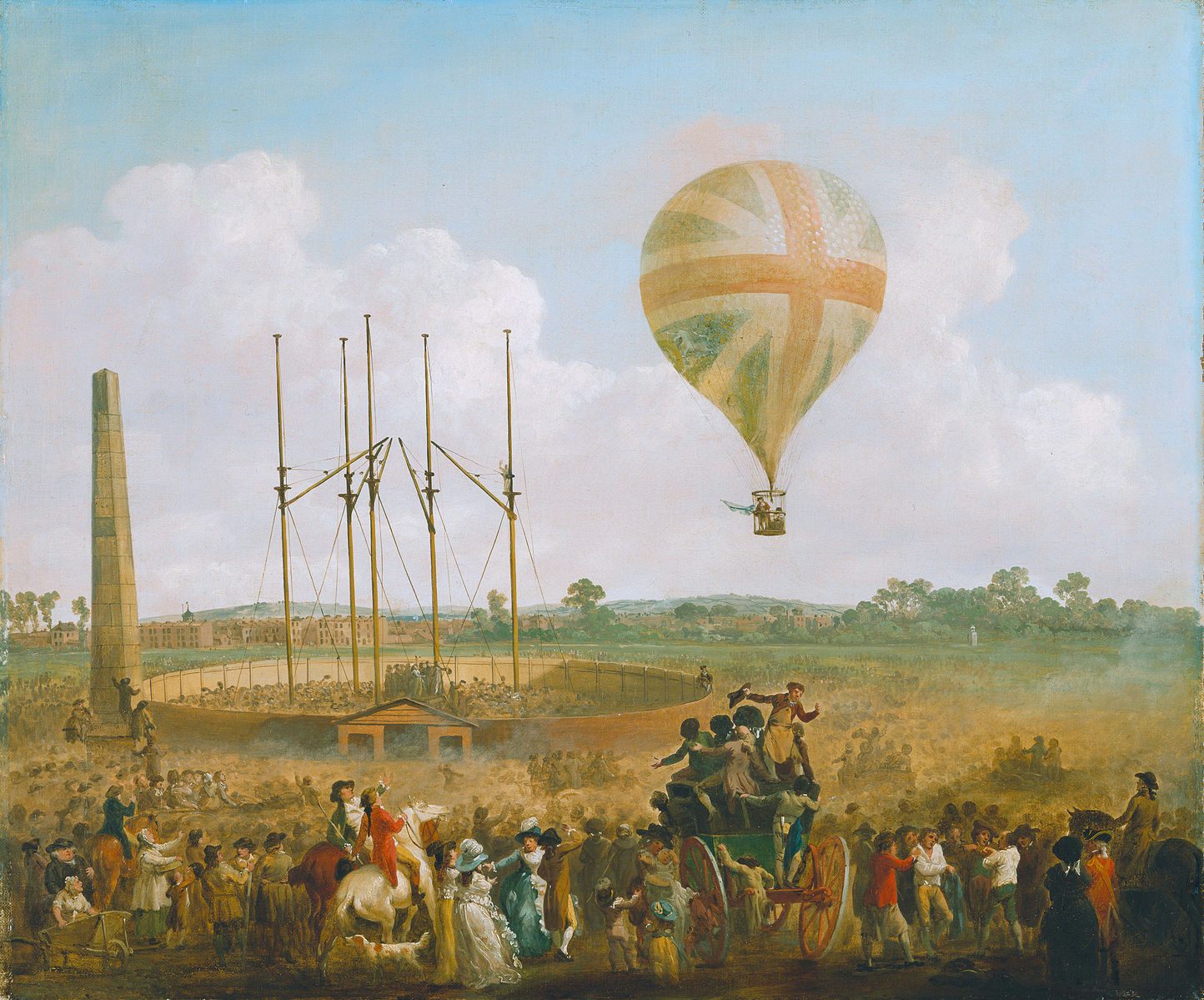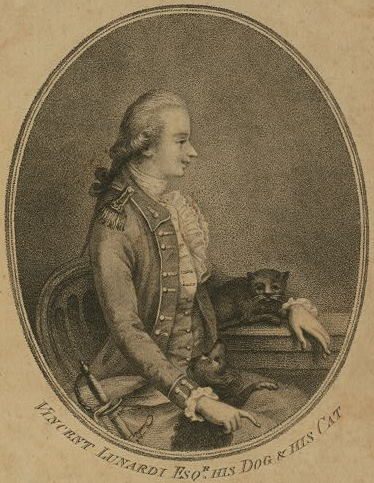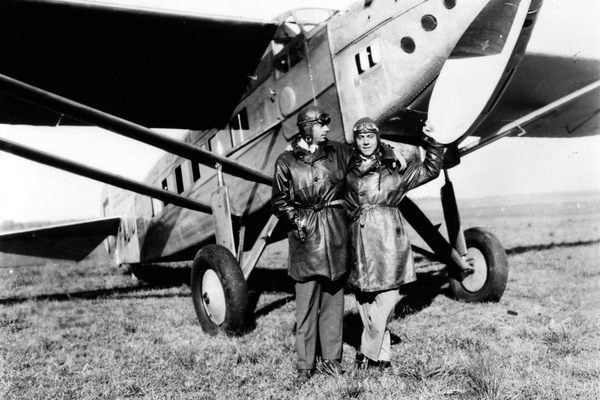The Most Inspiring Hot Air Balloon Ride Ever
Vincenzo Lunardi’s first flight over London featured two caged pigeons, an airsick cat, and a lot of solo drinking.

You probably know the names of the first people to fly an airplane, and the first person to set foot on the moon. You may know who won the race to fly solo around the globe, and who first outsped the speed of sound. But do you know the story of Vincenzo Lunardi, the first man to fly over England in a hot air balloon with a dog, a cat, and two pigeons? If you don’t, right now—exactly 233 years after this particular feat—is a great time to learn.
In his own estimation, Vincenzo Lunardi was made to fly balloons. Born in Italy in 1759, he’d started his career as a diplomat, acting as a secretary to the Neapolitan Assembly in England. While he was there, though, he became obsessed with accounts, mostly from France, of a new invention: the hot air balloon, a massive sackcloth filled with hydrogen that could float up into the sky, and take a human with it.
There was just one problem: the Londoners didn’t think he could do it. In fact, they didn’t think anyone could do it. While France had seen its fair share of ballooning success, whenever aspiring aeronauts had demonstrated in Britain, they had failed spectacularly, either damaging their balloons irreparably during takeoff, or failing to leave the ground at all. If they were successful—as in the case of James Tytler of Scotland, who managed to get aloft in August of 1774—they flew for so little time that spectators nearly rioted.

So when Lunardi came to London, he started by talking the talk. He drummed up enthusiasm for his endeavor by putting his balloon on public display, and distributing pamphlets that promised a “Grand Atmospherical Excursion!” Then on September 15, 1784, having built up a suitable amount of excitement, he walked the walk: he and his crew brought the balloon to London’s Artillery Grounds, pumped it full of gas, and took off.
Maybe it was the accumulated effects of high altitude—or maybe it was just his natural showmanship coming out—but the most breathless account of the flight comes from Lunardi himself. In a 16-page pamphlet called “Lunardi’s Grand Aerostatic Voyage,” the self-described “enterprising Foreigner” spelled out his adventure minute-by-minute.
First, off there was the crowd: “A hundred and fifty thousand Spectators, on a moderate calculation, composed of all ranks and descriptions of people” stood awaiting his launch at the Artillery Grounds, he wrote. In Lunardi’s description, doubters and believers mingled together, and the fields and surrounding buildings filled up with spectators of all ages, classes, and nationalities, jockeying for views.

Despite his celebration of the crowd’s diversity, Lunardi dedicated the entire pamphlet to the spectator of most import: George Augustus Frederick, then the Prince of Wales, who was 14 years old at the time. (He also put in a special shoutout to his favorite demographic: the gaggle, he wrote, featured “as great a display of female beauties as ever.”)
The crowd had made a good choice. In Lunardi’s telling, the drama started before the balloon even left the ground. While the crew was checking the envelope, one of the upright supports fell, knocking a high-up crew member off balance. Thankfully for Lunardi, he responded like a stuntman: “With great dexterity, he seized on a rope, and slid with coolness and unconcern to the ground,” Lunardi wrote.
There was even interpersonal drama. Around 1 p.m., Lunardi and his assistant, George Biggins, climbed into the basket but the load proved too heavy, and a disappointed Biggins was forced to climb back out again. “[Nothing] could be more visible than the regret which they felt on separating,” Lunardi wrote. (His aforementioned other basketmates—two pigeons, a cat, and a “favorite lap dog”—were allowed to stay.) After takeoff, there was another slapstick moment, as the balloon dipped dangerously close to nearby houses.

Lunardi threw out a bunch of sandbags, and one of his steering oars, and the balloon menagerie continued on its way. “The loudest acclamations rent the skies,” Lunardi wrote. “Some cried through excess of joy, some wept for his safety… the Prince of Wales drank to him, in a glass of wine.” From above, the ever-cool Lunardi “calmly waved his flag.”
After that, he was on his own. The rest of the journey was a mix of sprawling vistas, scientific experiments, and moments of peril. Although Lunardi steered as best he could with his remaining oar, air currents buffeted him to and fro, at one point blowing the balloon high up in the atmosphere, where the passengers were subjected to extreme cold. Icicles formed on his clothes, and “the cat was so benumbed as to be rendered motionless.” He himself almost fell asleep, and decided to drink several glasses of wine in quick succession for warmth, and to vigorously snuggle the dog, who, he thought, might not otherwise make it.
Looking over the basket was also dicey. Although he grew to enjoy the view—especially the clouds—at first it was so overwhelming that he was seized by “a sudden giddiness,” and had to step back. Later, though, he grew confident enough to lean over the basket’s edge, and to shout out at the public through his speaking trumpet. When he saw an acquaintance on the ground, he lowered the balloon enough to toss the traumatized cat overboard to him.

All told, Lunardi stayed aloft for a little over three hours. In that time, he traveled about 80 miles total, back and forth over a 26-mile stretch of land. He landed around 5 p.m., in a small village called Colliers-end, where a local farm girl helped him keep the balloon’s envelope from dragging on the ground. At this point, he was very cold, he wrote, and “the dog was very wet.”
Lunardi would go on to enjoy a long, storied career as an aeronaut, full of literal and figurative ups (he eventually earned the nickname the “Daredevil Aeronaut”) and downs (after a young boy died while crewing for him, he was forced to flee England for the United States). But this first ride over London set the tone, not just for his career, but for balloon travel in general. The balloon was placed back on display, and Lunardi himself became something of a sex symbol, a daring man who had ventured alone to parts unknown. His exploits even started a fashion craze: women began wearing “Lunardi skirts,” decorated with little balloons, and “Lunardi bonnets,” two feet high and designed to look inflated.
In the decades to come, balloonists would cross the English channel, head up to the stratosphere, and help to introduce audiences to the panorama, a brand new way of seeing the world. With his ride—and in his own words—Lunardi had successfully inaugurated, in one country’s imagination, “a truly wonderful and magnificent Machine.”


















Follow us on Twitter to get the latest on the world's hidden wonders.
Like us on Facebook to get the latest on the world's hidden wonders.
Follow us on Twitter Like us on Facebook